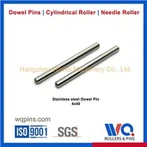Fastener Pin Rotational and Non-Rotational Looseness Analysis
The use of fastener pin connections is very extensive, and the problem that gives us a headache is the loosening of fastener pins during use. In response to this problem, the inventor has been designing a method to prevent the fastener pin from loosening, and there are many mechanisms that lead to the loosening of the fastener pin. Mechanism, the following is the first knowledge we share with you, I hope it will be helpful to you.
Rotational and non-rotational loosening
In most applications, fastener pins are tightened to apply preload in the joint. Loosening can be defined as the loss of preload after tightening is complete. This can happen in either of two ways. Rotational loosening, commonly referred to as self-loosening, is the relative rotation of fastener pins under external loads. Non-rotational looseness means that there is no relative rotation between the inside and the outside, but a loss of preload occurs.
Loosening of fastener pins due to non-rotational loosening
After assembly, deformation of the fastener pin itself or the joint may cause non-rotational loosening. This may be the result of partial plastic collapse of these interfaces. When the two surfaces are in contact with each other, the asperities on each surface are subjected to the bearing surface pressure load. Since the actual contact area of the bumps may be much smaller than the macroscopic area, even under moderate loads, the stress of the protruding parts due to the surface roughness will be greater than the yield strength of the material, and these protruding parts will bear very high local stress, resulting in plastic deformation.





